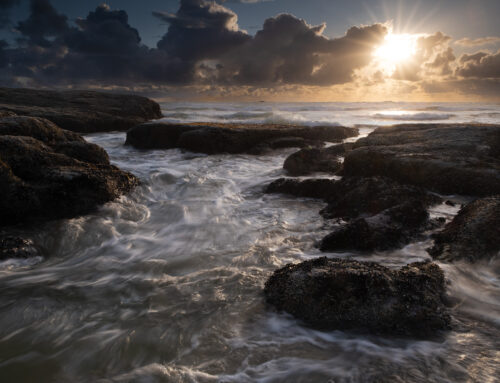I was in the Palouse recently with a workshop group and I happened to coin a new acronym, WITS, as part of my working with folks to help them improve their own compositions.  It may be a little corny, but it is something that helped folks during our time together and it’s something I thought I’d pass along to you. The Palouse can be one of the more difficult locations to photograph because many of the locations don’t have a specific identifiable subject that is easy to lock on to with your eyes and brain. It often involves more subtle creative work to compose a photograph based upon the shapes of the landscape, or the interplay between light and shadow. In other words, it can really flex our creative muscles! So, as we went about our days photographing, and, in the classroom image review that I conducted, you could often hear me say “WITS” or “do you have your WITS about you?”. It was a lighthearted way for me to remind folks about this concept.
It may be a little corny, but it is something that helped folks during our time together and it’s something I thought I’d pass along to you. The Palouse can be one of the more difficult locations to photograph because many of the locations don’t have a specific identifiable subject that is easy to lock on to with your eyes and brain. It often involves more subtle creative work to compose a photograph based upon the shapes of the landscape, or the interplay between light and shadow. In other words, it can really flex our creative muscles! So, as we went about our days photographing, and, in the classroom image review that I conducted, you could often hear me say “WITS” or “do you have your WITS about you?”. It was a lighthearted way for me to remind folks about this concept.
What is WITS you ask? Well, it stands for “What Is The Subject”. Seems like a simple question yes? It is on the surface, but it can also be an extremely difficult question when you are amongst the vast landscape of rolling wheat fields, or dense forests, or the deserts and sand dunes. As I’ve said before, if you are not clear with yourself “why” you are taking a photograph and “what is the subject of the photograph”, then perhaps the viewer will not know what it is and will not stop to look at your photo. I simply do not push the shutter button if I can’t confidently answer this question for myself. It’s a question that each and every photographer should practice asking themselves while composing and capturing an image.
In some compositions, the subject is very clear and easily  identified. It’s a waterfall, a creek, a boat, a sea stack, a bison, etc… Other times there may be two or more very interesting elements in the composition, say a rock and the sunset…which one is the “main” subject and which one is the supporting cast member? This is when it gets harder to know your WITS. You have to make the artistic choice and decide which is your main subject and what do you want to say about it, or how do you want to portray it. This will direct your composition. It’s only after you answer the question for yourself that you should compose your shot and press the shutter button.
identified. It’s a waterfall, a creek, a boat, a sea stack, a bison, etc… Other times there may be two or more very interesting elements in the composition, say a rock and the sunset…which one is the “main” subject and which one is the supporting cast member? This is when it gets harder to know your WITS. You have to make the artistic choice and decide which is your main subject and what do you want to say about it, or how do you want to portray it. This will direct your composition. It’s only after you answer the question for yourself that you should compose your shot and press the shutter button.

 To take the concept of WITS to the next level, you could ask yourself “what would someone else think the subject is?”. Oftentimes as photographers, we are on location and we have all the sights, sounds and smells, plus the context outside of our composition to inform our opinion of our photograph. But when we get back home and show it to someone who has never been there, they may interpret the photograph differently than you, simply because they don’t have the other contextual information that we had when we composed and captured the image. If you compose the image that the subject is clearly stated in the image, then any viewer might be more apt to identify the subject and your story. Making a subject more overt has a lot to do with positioning in the frame, it’s relationship to other elements, visual weight, lights/darks to emphasize elements and many other techniques that we can employ. By asking this second level of WITS, we can further refine and hone our composition so that our subject is clear to ourselves and the viewers.
To take the concept of WITS to the next level, you could ask yourself “what would someone else think the subject is?”. Oftentimes as photographers, we are on location and we have all the sights, sounds and smells, plus the context outside of our composition to inform our opinion of our photograph. But when we get back home and show it to someone who has never been there, they may interpret the photograph differently than you, simply because they don’t have the other contextual information that we had when we composed and captured the image. If you compose the image that the subject is clearly stated in the image, then any viewer might be more apt to identify the subject and your story. Making a subject more overt has a lot to do with positioning in the frame, it’s relationship to other elements, visual weight, lights/darks to emphasize elements and many other techniques that we can employ. By asking this second level of WITS, we can further refine and hone our composition so that our subject is clear to ourselves and the viewers.
Oftentimes with images that don’t have an overt subject, the concept of WITS can can still apply if  you think about changing the word “subject” to “intent” or “purpose”. What is the intent for your image, why are you taking the photograph, and is it clear in the way that you’ve framed up your composition? Sometimes it is the shape of the landscape or the shape of a feature. Sometimes it is the light and shadows that drive the intent. Whatever it may be, asking yourself why you are taking the photograph and is that intent clearly communicated in the composition. Even if you don’t consider other people and how they may interpret your images, at least consider your future self. 5 years in the future when you look at your image again, will you still feel the same connectedness, the same visual impact, etc as you do when you’re composing the shot? Gone will be all the emotional and sensory information you experienced when you made the image and you’ll be left with just the aesthetic qualities of the final composition. Will those be enough for you to consider the shot a good one? If you have your WITS at the time of capture, you stand a better chance of creating an image that will last the test of time.
you think about changing the word “subject” to “intent” or “purpose”. What is the intent for your image, why are you taking the photograph, and is it clear in the way that you’ve framed up your composition? Sometimes it is the shape of the landscape or the shape of a feature. Sometimes it is the light and shadows that drive the intent. Whatever it may be, asking yourself why you are taking the photograph and is that intent clearly communicated in the composition. Even if you don’t consider other people and how they may interpret your images, at least consider your future self. 5 years in the future when you look at your image again, will you still feel the same connectedness, the same visual impact, etc as you do when you’re composing the shot? Gone will be all the emotional and sensory information you experienced when you made the image and you’ll be left with just the aesthetic qualities of the final composition. Will those be enough for you to consider the shot a good one? If you have your WITS at the time of capture, you stand a better chance of creating an image that will last the test of time.
In my opinion, the biggest skill we can develop as an artist is always thinking about WITS. Too often we are overwhelmed with the excitement and beauty of being in a beautiful location and we just start snapping away without a lot of studied and conscious thought to “create” an image, not just “take” an image. The artistry and skill comes in the creation, not the taking, so to grow as an artists, one must always be asking if they have their WITS about them when they are behind the camera. 🙂





Leave A Comment